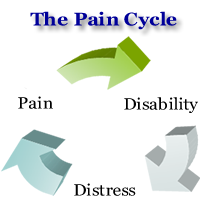Difference between revisions of "Pain management"
(Created page with 'Management Tips right The alarm system that alerts us some ailment being developed in our body is “Pain”. In a way we can say that pain is bi…') |
(No difference)
|
Revision as of 21:59, 20 August 2011
The alarm system that alerts us some ailment being developed in our body is “Pain”. In a way we can say that pain is biopsychosocial disorder. Pain can be debilitating. It is hard to define it. Being a subjective thing means different for different individuals. Some people don’t realities it to be a medical problem. While some think it to be a sign of weakness to acknowledge that they have pain. Neither is any test or device to measure it. Pain can be acute or chronic. Acute pain is relieved when the injury, surgery or illness is cured. Where as chronic pain persists. It can even disable a person. One can find it difficult to cope up with friends and family in case of chronic pain due to its severity. It may last or months or years. It can affect the person psychologically and physically.
Its devastating psychological effects are:
- Loss of mobility. Due to pain one may not be able to move around. One may not be able to have normal sexual relations and may be unable to take of the children also. This can affect a person emotionally.
- Depression. There can be a combination of immobility and depression. It may lead to irritability, nervousness (or anxiety) and an unhealthy desire for isolation. Marital conflicts develop and escalate.
- Sleep Disturbances. Sleep can be affected. It can contribute to depression. This can make a person prone to accidents.
- Medications. Side effects of medicines can lead to drowsiness. It may also lead psychological dependency on such drugs.
- Anxiety. Pain can induce anxiety due to increased muscle tension or spasms. Tension headaches, post heart attack pain and other pain syndromes affecting the musculoskeletal system may occur.
Management
One can rely on the following techniques for pain management:
Relaxation Training
Deep muscle relaxation and progressive muscle relaxation can help to relieve pain. For this you would need the help of a therapist or a counsellor.
Biofeedback
Special machines are used to learn to control our body function. Once the technique is mastered, it can be practiced without the use of the machine.
Visual Imagery and Distraction
You are taught to concentrate on the by imagining pictures of pleasant scenes or events or mentally repeating positive words or phrases to reduce pain. Negative thoughts can be eliminated. This can raise the levels of pleasurable brain chemicals, such as serotonin and the effectiveness of the immune system can be increased leading to lessening of anxiety. The mind conjures up mental scenes in order to better direct the body's energy. For instance, if an individual is suffering from a stabbing pain, he or she might want to imagine a knife being removed from the spot and a subsequent glowing feeling of relief. This technique has been used successfully to manage the pain of headaches, sinus problems, arthritis and cancer. Distraction techniques help us to focus our attention away from negative or painful images to positive mental thoughts. These can be activities like watching television or a favorite movie, reading a book, listening to music, or talking to a friend.
Hypnosis
Sometimes people are hypnotized by the therapist and sometime they are taught self hypnosis to manage their pain.
By individual and group therapy To overcome depression and anxiety one can take the help of a counselor or a therapist.
Exercise
Exercise is an excellent pain management technique that can eliminate injuries, strengthen muscles, tendons, ligaments and bones, maintain joint health, enhance flexibility and so much more.
Nutrition
Eating a balanced diet that is considered to be the best way raise your pain threshold or resistance to pain. A deficiency in any of the main vitamins (A, B, C, D or E) can cause chronic pain. Vitamin E is used to treat joint pain. A deficiency in calcium, iron, magnesium and other minerals may also lower your pain threshold. A calcium magnesium supplement taken in a 2:1 ratio of calcium to magnesium is thought to relieve joint pain and headaches. Manganese is a vitamin that is sometimes used for chronic headaches and neuralgia. A deficiency of the B vitamins is also thought to cause nervousness, headaches and chronic pain.

